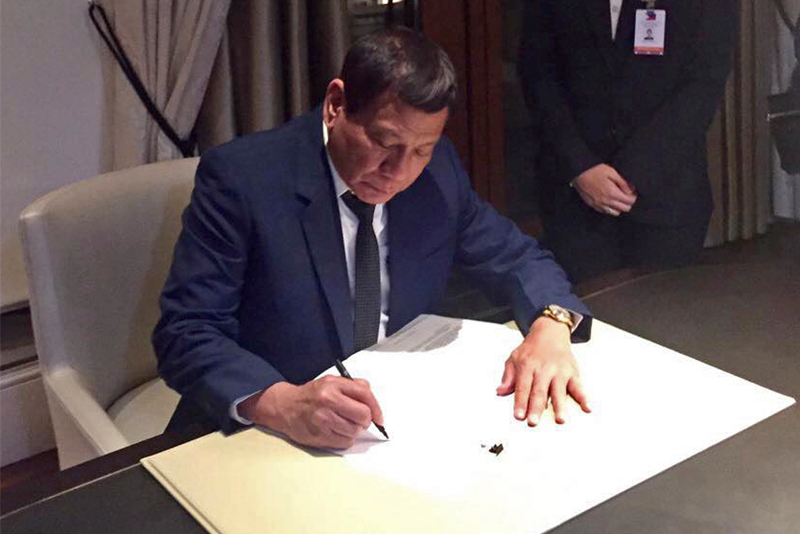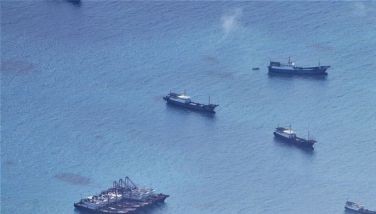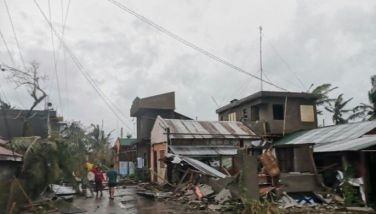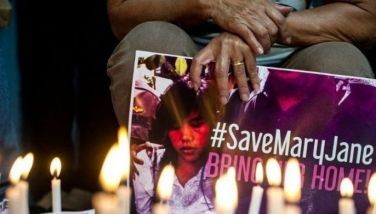More details emerge on how Duterte made martial law decision

This May 23, 2017, handout photo provided by the Presidential Communications Operations Office, Philippine President Rodrigo Duterte signs Proclamation No. 216, declaring Martial Law and suspending the privilege of the Writ of Habeas Corpus in the whole of Mindanao during his visit to the Russia Federation. Duterte declared 60 days of martial law on Tuesday across the southern third of the nation, an area that includes Marawi but extends well beyond it. ISIS-linked militants launched a violent siege in Marawi that sent thousands of people fleeing for their lives and raised fears of extremists gaining traction in the country. Presidential Communications Operations Office via AP
MANILA, Philippines — More details emerged on Friday about how President Rodrigo Duterte arrived at his decision to place Mindanao under army rule.
Citing a source in the presidential entourage in Moscow where the president was on an official visit and made the decision, The STAR reported that the president summoned Eduardo Año, the military chief, for an update on the clashes in Marawi City on Tuesday afternoon.
Año told the president everything was under control, according to the source of the newspaper. Still, he went on to order martial law in the southern region.
"Obviously, he decided on his own to impose martial law in Mindanao. He is obsessed with it and with replicating what the late dictator (Ferdinand Marcos) did," the source commented.
Sought by Philstar.com for comment on the account, Bong Go, special assistant to the president and one of Duterte's most trusted aides, replied: "No idea."
This new information surfaced as the president submitted to the Congress a report detailing his justifications for the declaration of martial rule on the Philippines' second largest island.
According to his report to Congress, the president made the decision after it became clear that the so-called Islamic State (IS)-inspired Maute Group tried to establish a province of the Middle East-based terrorist organization in Mindanao.
"Through these groups' armed siege and acts of violence directed towards civilians and government authorities, institutions and establishments, they were able to take control of major social, economic, and political foundations of Marawi City which led to its paralysis. This sudden taking of control was intended to lay the groundwork for the eventual establishment of a DAESH wilayat or province in Mindanao," the president told Congress.
Duterte also cited several acts of the group that showed their intent to remove Marawi City and eventually the rest of Mindanao from their allegiance to the Philippine government.
These acts were the cutting of lines of transportation and power, the recruitment of young Muslims to become their fighters to expand their ranks and strengthen their force, the consolidation of their members in Marawi City, the killing of some residents and the brazen display of IS flags, according to the president.
Duterte said Marawi City was a strategic objective for the terrorist groups considering its terrain and access to other parts of Mindanao.
Maute, a force?
An expert in terrorism in Southeast Asia, however, said that the Maute Group was small, and the military would not have a hard time dealing with it despite its connection to other terrorist groups in the region.
"Maute group is a small group. It is manageable. They feed off of or recruit from disaffected (Moro Islamic Liberation Front) combatants," Zachary Abuza of the National War College in Washington told Philstar.com
"Though they have pledged their allegiance to IS, there is no evidence to date that IS has given them any resources. This is a manageable threat, but it has been repeatedly mismanaged," he added.
That there is no sign the Maute is getting material resources from the Islamic State is a point the military maintains. The detail is crucial in establishing whether ISIS has presence in the country.
"We have not seen any concrete evidence of material support from IS," military spokesman Brig. Gen. Restituto Padilla said Thursday. But he added that the smaller groups like the Maute "are working to really get that recognition and funds, of course."
For some Mindanao experts like professor Julkipli Wadi of the Institute of Islamic Studies, martial law may give the Maute the international infamy it seeks.
Duterte placed Mindanao under army rule on Tuesday night following day clashes between Maute and Abu Sayyaf fighters and Philippine security forces who were trying to arrest leaders of the bandit groups.
The military was met by heavy bandit resistance when it attempted to arrest Abu Sayyaf subleader Isnilon Hapilon and some leaders of the Maute Group.
Based on the latest military information, the firefight between the two sides has so far killed 31 bandits, 11 soldiers and two policemen.
The fighting has also displaced thousands of Marawi residents, many of whom have left the city and gone to neighboring towns and cities, triggering what could be a serious humanitarian problem.
- Latest
- Trending

































